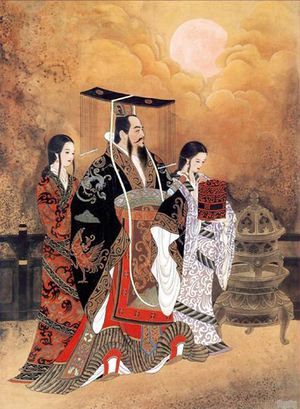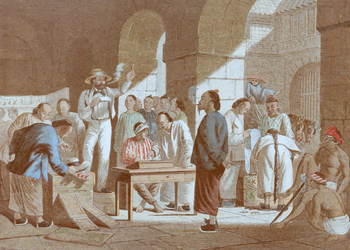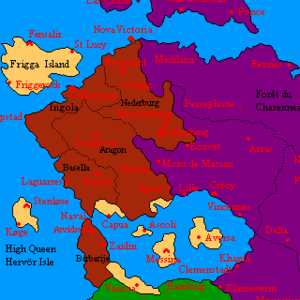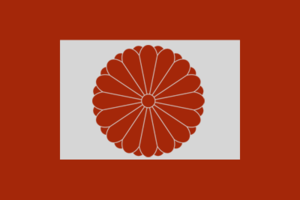History of Jing
This article describes the history of the Jing as a people before their ascension to power in Apollonian Jingdao. It describes the period before 1623 AN. Some parts of the article require revision, in accordance with the teachings of the Greater Jing School. The Great Jing Dynasty describes the Jingdaoese during and after the reign of the Haigui Emperor.
History
Origin

The very earliest mythological foundation of the Jingdaoese people predates their presence on the Cibolan continent and is closely linked with Soloralist and Catologian myths, and even Kildarian folklore. According to legends, the Jingdaoese became a distinct group in Airosamente (current Xiacheng, also known as Apollo City). The tales tell about how the Great Plague had rampaged throughout the world and had almost made all Mikrons go extinct. With that, the Era of Man had begun, and the Gods and Mikrons slowly left Micras for mankind to rule.
It was in Airosamente that mankind constructed a tower, the Tower of Airosamente, which would look over the world. It had to act as a symbol of unity of mankind, and its desire to reach the world of divine gods, who had left their world. The Gods were, however, not impressed, but saw the humans' attempts to enter Heaven as a grave insult towards the Gods who had so long taken care of humankind. No compromise between on how to act was reached between the gods, and they decided to wait and see.
In the mean time, greed overtook several of the leaders of Airosamente. Some of them started proclaiming the construction as a challenge to the supremacy of the Divine Beings, and not as an attempt to honour them. In those days, a young girl was born from the ashes of the earth and brought to live by Cato and His wife Germania. To avoid direct interference with humankind, and to show them the right path to follow, that girl was blessed with extraordinary power, charisma and wisdom. The girl, who was blessed with the name Sisera, began to preach and soon gathered groups of people around Her.
These became Her followers, who recognised in Her the words of the Gods. For years She preached in name of Germania and Cato, warning the people not to be overconfident. But the older She became, the more She was ignored. The number of followers decreased and many of them were forced to leave their family behind. This small group which entrusted Sisera with their life would later become the core of the Jingdaoese People.
On a certain day, when Sisera had already reached the age of 88, She spoke to the workers at the Tower, once more warning them for what they did. The workers, fed up with Her warnings, began to throw stones to Her and gave Her a slow and gruesome death. Those who followed Her came to Her help, but to no prevail. When they reached Her, the wounds that had been inflicted were too grave. She and Her followers would never forget what the Hun (impure) People had done to their Prophet, Daughter of Heaven.

When She entered the Mines of Germania, Her mother awaited Her and said She had deserved Her eternal peace more than anyone, even if mankind did not dare to listen to the Truth. Sisera knelt before Her mother and asked Her to give Her a new chance. She saw hope for the future and was convinced that She could rescue at least a few souls. Germania therefore listened to the pleas of Her Daughter and reincarnated Her.

The reincarnation came with a price: She would forever, till the end of times, have to return to Micras to save Her people from danger. Her reincarnations would be granted the power to experience things from Her previous lives. Later, based on this, the Heavenly Initiation Rites would be used to inaugurate the first High Priests under the Zuxiang Dynasty, and eventually as ascension rites of the Heavenly Light during the Erasmii Dynasty.
That being said, She returned to Airosamente, grew up among the love of Her followers, and once more led them on their crusade against impurity. Once more, the unbelievers mocked them, but in the end the punishment of the Gods made an end to the mockery. The Gods confounded their speech, so families and friends became divided and could no longer understand each other. Bloodbaths followed and, as usual, the Jingdaoese were blamed, as they had remained one solid group.
Humanity shattered and Sisera led Her people far away to a place where they would be safe, and could live in peace, harmony and spread the purity of their believes. Her people were thereafter led by Her descendants and, on occasion, Sisera would reincarnate. Not all descendants were blessed with the divine guidance of the Gods, but when they were, the people followed with a blind devotion. History will learn us that the Jingdaoese are - more than any other people - not attached to the land they were born on. Where there Heavenly Light is, they will follow.
In the end, it was the Ying Emperor of the Zuxiang Dynasty who in 351 bAN proclaimed the creation of a state for the Jing to live in. Aided by the High Priest Beneth ben Erasmus, the young emperor gave his people a new home, where they would stay until the reign of the Haigui Emperor, almost 1,900 years later.
Pre-Independence Era (1583 - 1592 AN)

The true history of Jingdao is - ironically - linked with the nation it would later govern: the Kingdom of Batavia. Throughout the reign of King Arkadius II des Vinandy several Batavian governments made attempts to increase the prestige of their nation (and appeal to the growing imperialist and nationalist groups within the country).
Industrial growth had led to an immense increase in population, surplus, which in turn led to new social tensions. Numbers of concerned people who also saw an increase in rules and laws (especially because of the liberal party, which pushed through an extensive expansion of the law system) and felt that there freedom was slowly limited, wanted to move to a less bureaucratic place.
It was then that groups of Batavian sailors and military men looked southwards, to the Cibolan continent. West of the Empire of Alexandria was untamed territory: peoples like the Aragonese, Saxons (Nederburgians) and Qingdaoese would be no match for the military might of Batavia. The earliest attempts to settle a decent colony, Aragon, found place in 1526.

The large amount of small settlements and colonies would eventually, under pressure of the early colonists, be united under a loose union called Batavian Cibola. From that moment, more and more colonists moved land inwards. This is also seen as the moment in which Batavian colonists and locals start to work together. Certain mixed communities start to grow, and the colonists made their first contact with the Saxons and Qindaoese who lived more eastwards (and who would later become known as the Jingdaoese).
The existence of the Batavian Cibolan colony was quickly challenged when in 1557 a civil war broke out between the Nederburgian, Aragonese and Batavian forces. The war was ended, but at the cost of hundreds of lives and a growing distrust.
In 1571 the Batavian Cibolan colonies were reformed and placed under a more centralised administration to combat political ineffectiveness and corruption. The colonies also underwent a name change, becoming Great Aragon, and saw the introduction of former Aragonese symbols. The attempts to spread democratic ideals in this region became very unpopular when massive electoral fraud was discovered in several local elections.
Through the ages, dissatisfaction with colonial rule would only grow slowly. It would take till chaos on the Homelands became clear and civil war broke out in the North, that the colonists and colonials took power in their own hands. The real birth year of the South Batavian nation is 1583, the year in which Herman Civilis became Grand Duke of the southern colonies and formed the Grand Duchy of South Batavia.

The ancestors of the Jingdaoese would watch most of the events which unfolded during these colonial years from a distance. The Qingdaoese, who had lived ages without the guidance of a descendant of Sisera, had retreated themselves behind the safe mountains and lived a prosperous life with the gold they found in their mines. It would be till the arrival of the Erasmus Dynasty in Nederburg (north of the Qingdaoese valley), that the group would start actively participating in politics again. With the rise of Herman Civilis and the presence of Erasmii, the Jingdaoese started backing the colonies with both manpower and financial means. The isolated Qingdaoese region would become the cradle of later imperial power. They once more took up the name Jingdaoese, as they felt that the moment was right.
While civil strife had unfolded in the north, South Batavia remained part of the Batavian nation and flourished while increasingly expanding its industrial power. It saw important (symbolic) events like hosting Expo 2012, an intermicronational world exhibition, in the Nederburgian city of Heemecht.
Times were changing, and time seemed to have ran out for the old Kingdom of Batavia. Herman Civilis left office, just before he died, in favour of Mordechai ben Erasmus. Mordechai would later become known as the first Emperor and would prepare the path towards independence. In 4779 ASC, his son, the later Kaiming Emperor would declare the southern colonies free from the Batavian oppression and establish an empire which would influence the politics of many Micrasian countries.
First Empire (1592 - 1602 AN)
Colonial Resistance and Independence

In less than 250 ASC years, the Cibolan colonies had grown from a set of backward colonial settlements and villages into a dependency with a certain amount of prestige. Simon ben Erasmus, son of Mordechai, inherited a Grand-Duchy which was flourishing. But dark clouds were gathering in the north: conflicts and crises followed each other and it became clear that Batavia was looking to its colonies to carry most of its financial problems. In a daring move, Simon resisted against the government in 's Koningenwaarde and proclaimed the end of what he perceived as an unequal relationship between the Fatherland and its colonies.
The Empire of Southbatavia and Jingdao was established and from one day on another, the soldiers and public servants who had been ruled by their northern masters received the news that they would now serve an Emperor who was truly blessed by Heaven. The Kaiming Emperor became the first true Emperor and Heavenly Light, endorsed by the Catologian Church, but was confronted with much scepticism from several layers of the population. One of His first acts was to raise his father into status. Mordechai, who had served the Realm both as Prophet and ruler, was proclaimed posthumously the Mengjiang Emperor, which gave His own ascension to the Throne some feeling of continuousness.
Threats to the Dynasty
With the energy of a young man, the Kaiming Emperor introduced a number of reforms, announced construction programs - especially to improve the IJzerbaan (railway network) and replaced disloyal servants by more loyal ones. Peasant revolts were quickly beaten down and massive food programs were started throughout the nation. Diplomatically He was successful in receiving recognition from both the old homeland as other realms. While documents contradict themselves, historians agree that the Tegong was also established in this period with the duty to serve the Heavenly Light with utmost dedication. The power entrusted to this organisation would soon lead to confrontations within the administration and would even threaten the reign of the Emperor it was meant to protect.

While loved by His people, the Emperor was also confronted with an alarming increase in birth rate, a result of the stability during the reign of His father and own early reign. It didn't take long before Jingdao was confronted with logistical and social problems because of the surplus population. Corruption was widespread and made the well-intended aid to battle poverty ineffective in some provinces. While the Emperors were often loved and even worshipped, the government saw several peasant uprisings during the 1591 AN and onwards. During one of those uprisings, a young sergeant, Yuan Windsor, defended his post with a handful of soldiers against a mob of over 10,000 peasants. Yuan soon became a rising star within the military and within the year, in 1592 AN, he was chosen by the Kaiming Emperor to "clean up the house". His appointment as Diwang led to an immense power shift from the Throne to a simple nobleman.
The Imperial Court was, and had always been, a battleground of several groups: the Armed Forces (the Army, because the Empire lacked a decent Navy in those days. This would change during the Second Empire), the Catologian Church (which would later lose a lot of its power to the Bureaucrats) and civil authorities were in a constant struggle to gain power and influence over the decisions made by the Grand Secretariat.
In those days the Emperor had been ruling His Realm from behind the safe walls of Zijincheng, the capital city which was limited to access by only carefully-chosen personnel and high officials (a policy which had been copied for the Palace of Daocheng). Well-intended Decrees were published here and spread throughout the country, but because Yuan was the one who actually left the huge palace complexes, he succeeded in gaining more and more power over time. As a man of the military, he favoured the growth of the Armed Forces and sought to reduce the powers of the clergy. This brought him into conflict with the Magister of the Church, Miguel Windsor (who was a distant family member).
The Shanglu Campaigns and Yuan Rebellion
The Magister was successful in convincing the Emperor to leave His palace more frequently and to regain some of the lost influence. The plans of Yuan, to gain power through legal means were temporarily foiled. The Emperor, neither blind nor deaf to the cries of His people, became convinced that the colonisation of the barbarian southern lands was the fastest and best solution to solve the overpopulation.
Campaigns were held throughout 1593 AN and the province of Barbarije was successfully integrated into Jingdao after the defeat of several tribes. This was followed with a new military campaign was launched and personally overseen by the enthusiast Emperor. With His army He moved further southwards against Shanglu, to integrate it into the nation. The campaign was successful, but the Emperor was betrayed, ambushed and kidnapped. Many thought He was dead, and the Diwang took the chance to consolidate his power. Yuan Windsor proclaimed himself Regent in the absence of the Emperor and sought to make Grand Duchess Sisera into his puppet. This plan failed miserably and a group of soldiers - together with corrupt Tegong agents - was dispatched to Zijincheng to murder the heir to the Throne.

The battle which followed destroyed a part of the palace complex and many Imperial Whites (the name of the ceremonial imperial guards) were killed in surprise before they could act. Sisera escaped thanks to the support of Tegong agents who had remained loyal to the Throne. The escape of the Grand Duchess led to confusion throughout the Empire: a part of the population rallied behind the Diwang, others behind the heiress. She retreated into the mountains, from where she frequently raided caravans with gold for the Diwangs treasury.
Revenge of the Kaiming Emperor
It took another year before the Kaiming Emperor - who had escaped his kidnappers and had lived on a cabbage farm in Shanglu - came out of hiding, rallied a part of the army behind him and took power back. After a short and bloody year, both sides agreed to hold a truce: Basella became part of a Yuan-led state known as Yuandao, while the rest of the Empire stayed loyal to the Emperor. In 4877 ASC a more definite peace treaty would be signed in Rijnsburg (in Nederburg). Yuan entered the conference room, where on first sight many important nobles and the Emperor Himself were present. It turned out to be a trap, as a way of payback for Yuans own treason. The doors were closed and locked, so nobody could leave, after which hundred thousands of equine mantises were unleashed and killed and ate all guests in the room (including the actors, some nobles and a Babkhan dignitary) alive. The Empire was finally reunited. The harsh attitude towards traitors would become part of Jingdaoese culture and habits.
In the wake of the Yuan Rebellion, a number of Jingdaoese merchants and politicians, under the leadership of Jack Mounford, who was head of a Catologian military order, sailed to the island of Calbion. Calbion was admitted as a largely autonomous province shortly after. Although Jack Mounford as Prince of Calbion had always been loyal to the Jingdaoes government, relations between Calbion and the Imperial Government have at times been strained. Several incidents occurred that made Sisera question the Calbain loyalty. These tensions reached a highpoint when Calbion declared independence. Refusing to accept, Sisera ordered her troops to attack the island. The Calbain Independence War resulted in the destruction of a large part of the Calbain nation.
First Diaspora (1602 - 1604 AN)
- See also: Jingdaoese Diaspora
In 1602 the Ci Emperor was forced into a battle with evil spirits which attempted to escape into the world of Micras. The fight lasted many days and nights. In the end, the total destruction of Cibola was ordered. Many lives were lost, and only a small part of its original population escaped. Awaiting the return of a Heavenly Light, many Jingdaoese spread throughout the world.
Second Empire (1604 - 1623)
The Empire of Jingdao-At-Sea
While Jingdao had been destroyed and many of its people roamed the world in hope to find a new living place, a Myxosean with the name Rollin Mor'Ler had gathered a number of Jingdaoese around him. His expedition, meant to find a place where both Jing and Myxoseans could live in peace, brought them to the Antican Isles to the east of the Apollonian continent.
Having been declared King of the Kingdom of Seven Isles, he came into a conflict with his two sons: his heir, Pius Mor'Ler knew that plans existed to return power to the Erasmii Dynasty. Swayed by Jezza ben Erasmus, Pius' brother (bastard son of Rollin) - Magister of the Church, Andreas Mor'Ler - became convinced that the kingdom was doomed if the Erasmii Dynasty didn't ascend to the Throne.
Andreas called upon his faithful believers to protect the realm's divine future, took out his knife and stabbed his brother in the stomach during a church ceremony. King Rollin, shocked by what happened in front of him, and the utter lack of emotion of both his bastard son, the public and his royal guard, sank away in a depression, abdicating from the Throne in favour of Jezza, who was proclaimed the Duchang Emperor.
During the early days of the reinstituted Empire. The city of Tie Gang, then known as Tyrenia, became part of Jingdao. It expanded into an important mercantile hub for the Empire, which it remains till this day.